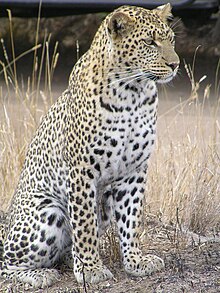The leopard , Panthera pardus, is a member of the Felidae family and the smallest of the four "big cats" in the genus Panthera, the other three being the tiger, lion, and jaguar. The leopard was once distributed across eastern and southern Asia and Africa, from Siberia to South Africa, but its range of distribution has decreased radically because of hunting and loss of habitat. It is now chiefly found in sub-Saharan Africa; there are also fragmented populations in the Indian subcontinent, Sri Lanka, Indochina, Malaysia, Indonesia, and China. Because of its declining range and population, it is listed as a "Near Threatened" species on the IUCN Red List.
Compared to other members of the Felidae family, the leopard has relatively short legs and a long body with a large skull. It is similar in appearance to the jaguar, but is smaller and more slightly built. Its fur is marked with rosettes similar to those of the jaguar, but the leopard's rosettes are smaller and more densely packed, and do not usually have central spots as the jaguars do. Both leopards and jaguars that are melanistic are known as black panthers.
The species' success in the wild is in part due to its opportunistic hunting behavior, its adaptability to habitats, its ability to run at speeds approaching 58 kilometres per hour (36 mph), its unequaled ability to climb trees even when carrying a heavy carcass, and its notorious ability for stealth. The leopard consumes virtually any animal that it can hunt down and catch. Its habitat ranges from rainforest to desert terrains.
Variant coloration
 |
| Melanistic leopard or "black panther" |
The black panther is common in the equatorial rainforest of Malaya and the tropical rainforest on the slopes of some African mountains such as Mount Kenya. Between January 1996 and March 2009, Indochinese leopards were photographed at 16 sites in the Malay Peninsula in a sampling effort of more than 1000 trap nights. Of 445 photographs of melanistic leopards taken, 410 came from study sites south of the Isthmus of Kra, where the non-melanistic morph was never photographed. These data suggest the near fixation of the dark allele in the region. The expected time to fixation of this recessive allele due to genetic drift alone ranged from about 1,100 years to about 100,000 years.
Melanism in leopards has been hypothesized to be causally associated with a selective advantage for ambush.
Man-eating
Most leopards avoid people, but humans may occasionally be targeted as prey. Most healthy leopards prefer wild prey to humans, but injured, sickly, or struggling cats or those with a shortage of regular prey may resort to hunting humans and become habituated to it. Although usually slightly smaller than a human, an adult leopard is much more powerful and easily capable of killing them. Two extreme cases occurred in India: the first leopard, "the Leopard of Rudraprayag", may have killed more than 125 people; the second, the "Panar Leopard", was believed to have killed more than 400, after injury by a poacher made it unable to hunt normal prey. Both were killed by hunter Jim Corbett. Man-eating leopards are considered bold and difficult to track by feline standards and may enter human settlements for prey, more so than lions and tigers. Author and big game hunter Kenneth Anderson had first-hand experience with many man-eating leopards, and described them as far more threatening than tigers:
In July 2012, two people were killed by leopards in separate attacks in distant parts of India.Although examples of such animals are comparatively rare, when they do occur they depict the panther [leopard] as an engine of destruction quite equal to his far larger cousin, the tiger. Because of his smaller size he can conceal himself in places impossible to a tiger, his need for water is far less, and in veritable demoniac cunning and daring, coupled with the uncanny sense of self preservation and stealthy disappearance when danger threatens, he has no equal.—Kenneth Anderson, Nine Man-Eaters and One Rogue, Chapter II "The Spotted Devil of Gummalapur""













0 comments:
Post a Comment